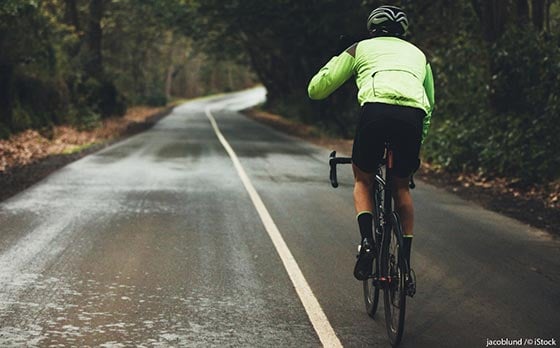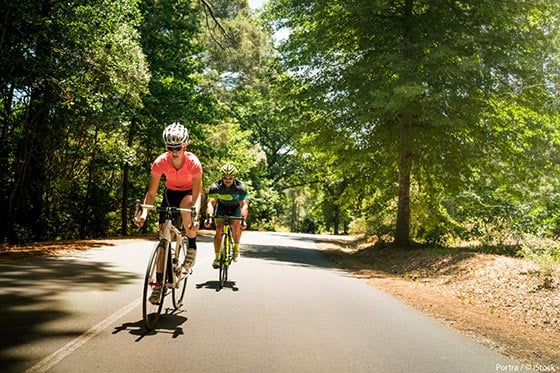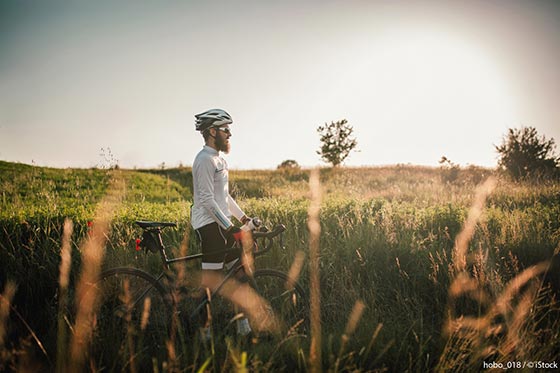Road bike training for beginners
Training plan and important tips to get started with your training

Cycling is perfect for endurance training and muscle building, while being easy on the joints. In this article, we'll go through an effective training plan and offer important tips for beginners. With tips for cycling beginners and our training plan under your belt, you'll have all you need for successful start.
We'll show you how to build up endurance and give you all you need for a good start.
- 4 important tips before exercising
- Bike Handling: Your first and most important goal
- Cycling exercise plan for beginners
- Why is athletic recovery so important?
4 important tips on cycling training
So your cycling training goes as planned with no unexpected hiccups along the way, be sure to pay attention to the following four tips.
1. Exercise regularly
Only regular training leads to progress. Train twice a week for 30 minutes instead of three hours every two weeks. Take a break for a maximum of one week, except when sick, of course. Only once you've fully recovered should you slowly increase exercise intensity again.
2. Avoid peer pressure
Train only with a group or friends whose athletic ability is similar to yours. If your training partner is too fast and you overexert yourself to keep up, your performance will deteriorate in the long run instead of improving.
3. Add in stretches
Leaning over a bike puts added stress on the back, neck and shoulders. Due to this unaccustomed position, many beginners suffer from back, neck and shoulder pain. This is normal and improves with time. It's therefore important you stretch on a regular basis. This way you can overcome any potential muscle pain.
The following video will give you an overview of stretches for cyclists:
We explain how to find the right bike frame and saddle in our article, „Bike size: Find the correct frame size and saddle position“.
4. Don't forget food and drink
Never underestimate cycling training. Always bring enough water, no matter how far your route will take you.
If you are on the bike for more than an hour, bring something to eat with you. Good snacks include:
- Bananas
- Oat bars
- Energy bars
Bike Handling: Your new goal

Riding a road bike is often unusual and difficult at first because of the thin tires and bent upper body position. It's normal to have a stiff upper body when beginning your training.
For your first road bike excursion, look for an empty parking lot. Be sure that you have the following down:
- braking (also in wet conditions)
- safe straight riding
- clicking your shoes into and out of the pedals
- riding in tight curves
- gear changing
- jumps to avoid small obstacles
The following videos shows different exercises that will help you master the before-mentioned skills.
Road bike training plan for beginners
Before we provide you with an exact training plan, you should know how to structure your exercises and adapt them to your individual needs.
Cycling training for beginners: speed, distance & difficulty

The following points are crucial in road bike training:
- Training Sessions:
As a beginner, you should train twice a week. - Route:
For beginners, we don't recommend using distance as a benchmark for training sessions. 40 Miles in the mountains are much more difficult than 40 miles on flat land. - Duration:
Instead of training by mileage, train on time. This depends of course on your fitness level and on how much time you are willing to give to training. As a rule of thumb, 30 to 60 minutes should be good for beginners. - Speed:
Cycling beginner training sessions should be in the range of basic endurance GA1.
What does GA1 mean?
GA1 refers to the basic endurance range one. In this area you train aerobically, which means you are burning fat. In this range, you should be able to breathe easily and have a relaxed conversation. In this range, you should be working within 60 to 75 percent of your maximum heart rate. In the GA1 range, you train long-lasting endurance and form the foundation for athleticism.
If you don't have a heart rate watch, make sure that you can talk relaxed while exercising. If you can't, slow down.
Periodisational training
Periodisational means dividing training into phases which focus on different goals.
You can increase the training time by about 10 percent per week. For our example we have chosen a time of 40 minutes to begin with. Be sure to adjust the time to your needs.
First week
Time on the bike per week: 2 x 40 minutes
Recovery Phase: 48 hours
Stetching: 2 x 30 minutes
Second week
Time on the bike per week: 2 x 45 minutes
Recovery Phase: 48 hours
Stetching: 2 x 30 minutes
Third week
Time on the bike per week: 2 x 50 minutes
Recovery Phase: 48 hours
Stetching: 2 x 30 minutes

Fourth week: Recovery week
The fourth week is a regeneration week. Train as you did three weeks ago, to give you body the time it needs to recover and allow you a leap in athletic performance. Find our why the recovery period is so important in the next paragraph.
Time on the bike per week: 2 x 40 minutes
Recovery Phase: 48 hours
Stetching: 2 x 30 minutes
Fifth week
Time on the bike per week: 2 x 50 minutes
Recovery Phase: 48 hours
Stetching: 2 x 30 minutes
Sixth week
You can now continue increasing your training window by ten percent each week while adding a recovery week every three weeks. During the recovery period, train as you did three weeks ago.
Goal
The goal of this training plan is to be able to bike for three hours while remaining in the GA-1 level of athletic performance.
Once you've reached your goal, you're no longer a beginner and should continue to increase training intensity. You can increase one or more of the following parameters:
- Exercise sessions per week
- Session length
- Ride through hills or mountains
- Pedaling speed
We also recommend changing small aspects of each training session. By varying the training, your body experiences different stimuli and becomes stronger. If you've reached a plateau in your performance, give interval training a shot.
Why is a recovery period so important?

Know your fitness boundries. Overexertion will greatly reduce your performance, making your risk to injury that much higher. You can read more about over exertion in our article „Over-training: Causes, symptoms and treatment“.
Many are unaware that performance increases take place during these breaks. Torn muscle fibers are rewoven during recovery periods. This means after training, the body regenerates and recovers to prepare itself for the next training session.
The recovery period refers to a period of recovery between training sessions. Especially in the beginning phases of training, your body needs at least 48 hours to regenerate and recover. You should not train during this time.
Motivation is the best training.
Each body is different and so is every path to success. Stick to your training and don't let yourself get demotivated if you have a bad week. Also look for role models who motivate you. How about Austrian cyclist Christoph Strasser and his ride to a world record in Australia.
We wish you the best in getting started with cycling!
In case you're still looking for the right cycling jersey, take a look at our owayo store and start designing your own jersey in our 3D Designer today.